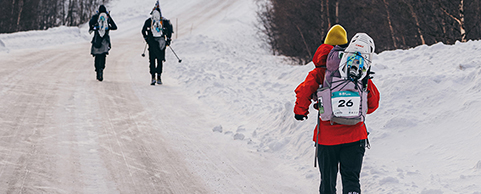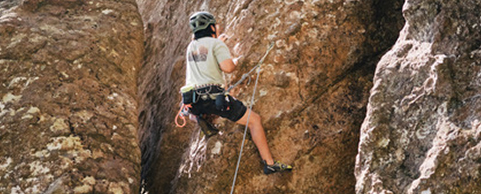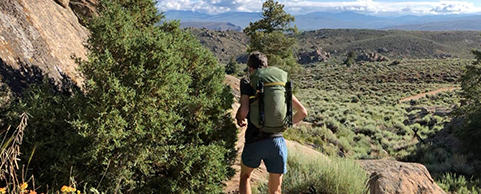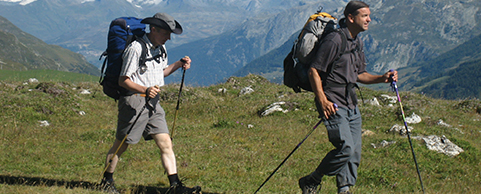Via Ferrata
What is Via Ferrata?
Via Ferrata is an Italian term which translates to iron way in English. It describes a route fixed up a cliff or mountain using steel cables for the climber to clip into for protection. Access may be facilitated by ladders or metal rungs on particularly steep sections. In this way routes up peaks become accessible to persons who would not otherwise be in a position to attempt them.
Specialised equipment is required which is, of course, sold by Bogong. It is possible to hire guides for Via Ferrata ascents from the mountain refuges and villages in Via Ferrata areas.
Via Ferratas originated in the Italian Dolomites where the routes were fixed to give access to soldiers in the First World War. After the war the Italian Alpine Club continued maintenance of these routes for recreational climbing. Of recent times they have proliferated throughout continental Europe and can be found in Austria, Switzerland and France. In German speaking countries they are known as Klettersteig.
 |
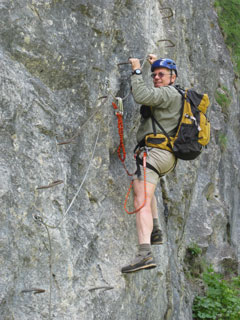 |
 |
| Italy | France | Austria |
Where are Via Ferrata?
ITALY
The Italian Dolomites is the most popular destination for Via Ferrata climbing. Via Ferrata in the Dolomites often climb to the top of a mountain peak which means you have a sense of going somewhere. Sometimes the descent is a walk but often a peak will have at least two VF’s leading to the summit, a harder one and an easier one that is used for the descent. Of course you are perfectly able to climb the peak using the easy route but be aware it is always more difficult descending than ascending. The Dolomites also have a number of WW1 historical routes which incorporate sections through tunnels excavated in the war years which are absolutely fascinating to see. The best thing from an English speaker's perspective that all Via Ferratas in the Dolomites are described in the excellent cicerone guides Via Ferrata Italian Dolomites Vol 1 & Vol 2.


FRANCE
Over the last 20 years or so special purpose Via Ferrata have been created in many areas of the French Alps. These are constructed to a very high standard and often incorporate extras for thrill seekers such as cabled monkey bridges. These routes tend to be set up cliff faces, often on the steepest and most spectacular sections, as opposed to Italian ones that may be following a route to a summit. As such they are much more artificial. Many comprise long sections of metal rungs fixed to the rock to climb on instead of the rock itself. A word of warning, the higher grade routes in France are steep, gymnastic and sustained and require upper body strength. These routes are not to be undertaken lightly. Newly published in 2014 is an English language cicerone guide Via Ferratas of the French Alps. Cordee also published an English Guide Via Ferrata – a complete guide to France. It has wonderful photos but you will be lucky to score a copy as it has been out of print for at least 4 years.
AUSTRIA
Like France the Austrians have taken to constructing VFs recently with great enthusiasm. The mix of routes is somewhat a mix of the Italian and the French, with many quality mountain routes mixed in with cliff routes. A number of mountain huts have constructed routes nearby to attract visitors. Many mountains and pathways in Austria have had cables fixed to aid access for many years but dedicated climbing routes are more recent. There is no English language guide but there is often excellent online info available from regional tourist offices with easy to follow topo guides such as this one of the Ilmspitze in the Stubai Alps. See the links section below.
SWITZERLAND
Swiss Via Ferrata are similar to Austrian ones. My experience of these is limited. There is an English language Guide Via Ferrata Switzerland by Rother which is not entirely up to date.
What Gear Do I Need?
As mentioned above, a Via Ferrata is a fixed-protection climbing path. The protection consists mostly of heavy-gauge steel wire, periodically fixed to the rock, onto which the climber clips. Each climber needs the following equipment:
- Harness. Any rock climbing sit harness is satisfactory although the best ones are the non-padded highly adjustable ones because they are the lightest. The added comfort of a padded harness is not required because you shouldn’t be actually hanging in it. As you will be carrying a rucksack a full body harness offers the highest level of protection although in my observation these are seldom used except with children.
- Via Ferrata Protection Set. This is a specialised self belay system which forms a secure attachment between your harness and the cable. It comes with an in built shock absorber in case of a fall and special easy locking clip carabiners. Please note because of possible high shock loadings a standard sling and carabiner to clip in with is dangerous and should not be used.
- Helmet. These routes can be busy and a helmet is as much a protection from potential dislodged rocks by others above you as protection against falls. Any climbing helmet is suitable.
- Footwear. If you are just doing a few casual easy routes runners or walking boots will suffice but the best footwear by far is a pair of climbing approach shoes. They are easy to walk in to get and from the route and offer perfect traction on it. Note standard rock climbing shoes with smooth soles are NOT suitable.
- Gloves. Leather roping gloves, particularly fingerless ones are usefull to protect the hands from not only the cold but fraying cables.
- Extra Equipment. A sling with two carabiners can be useful for resting on or sticky situations. A prussick could also be useful for extra protection. A short piece of rope for setting up a belay across sections where the cable may stop but nevertheless have considerable exposure might be handy also. It is not the purpose of this blog to explain how to use this equipment but it is useless carrying it unless you understand the safe use thereof.
Via Ferrata Grades
Italy
In Italy climbs are graded from 1 to 5 in order of ascending difficulty with a secondary letter grade of A, B or C which indicates the level of seriousness. This takes into account such factors as the availability of escape routes, fitness required and possible unprotected sections. Therefore the easiest grade is a 1A up to 5C as the most difficult. A complete explanation is given in the Cicerone guides.
Grade One is little more than a scramble that could often be undertaken by confident parties without equipment. Grade 2 and 3 routes will take you to airy places but even on a grade 3 you should always have a good foothold and handhold. Note a 3C may have unprotected easy sections that some parties could find intimidating. Grade 4 and 5 offer increasingly steep and sustained climbing and arm strength may become an issue. I suggest you start at the bottom and work up to your comfort level.
Austria/Switzerland
Austria and Switzerland use a letter grading system for difficulty going from A to E (hardest) The A to E roughly translates to the 1 to 5 of the Italian system although in my experience each of the grades is perhaps half a grade harder than the Italian ones. ie a B is a 2.5, C a 3.5 and so on. Many routes have guides with individual sections graded. See Ilmspitze topo for an example of the Austrian/Swiss grading system.
France
French Via Ferratas use the French Mountain climbing grading system. NB: although these are the same designations as mountain grades they in no way are equivalent across the two systems. Descriptive letter grades are used.
F (Facile) Easy, PD (Peu Difficile) Not very hard, AD (Assez Difficile) Fairly Hard, D (Difficile) Hard, TD (Tres Diffiicile) Very Hard, ED (Extremement Difficile) Extremely Hard
I have never seen a grade comparison table but French PD is ~ Italian 2B, French AD ~ Italian 3B. French grade ED is certainly harder by a far margin than Italian 5C and is not to be trifled with.
Hazards
Potential hazards are many and various, but provided you have good mountain sense this form of recreation is surprisingly safe, particularly at lower grades. The greatest hazard is probably stone fall caused by others above you. Therefore a helmet is absolutely essential, as is an awareness as to when you should wait to let the way clear. You should take the utmost care not to dislodge loose rocks on others below.
Lightning is also a potential major hazard as you are clipped to what is in reality a giant lightning rod. Summer weather in the alps is often clear in the mornings with thunderstorms building up in the afternoon. Apart from checking forecasts the moral is to leave early. A good head for heights is certainly a requirement. A Via Ferrata is not a good place for vertigo sufferers. Lack of knowledge as to how to use your equipment correctly, how to bypass others safely, and poor attention to details are other possible hazards. Guiding services are widely offered throughout the Alps to get you started safely until you feel confident to strike out on your own.
More Information
Italy:
All you need is in the aforementioned books.
Austria:
https://www.stubai.at/en/activities/climbing/via-ferrata-trails/ Excellent site. English language Stubai Valley tourist site. (Near Innsbruck) Links to excellent topo guides of via ferratas in the region and English descriptions.
https://www.mayrhofen.at/en/summer-vacation-family/climbing-via-ferrate/ Average Site. English language. Info on Via Ferrata in the Zillertal region.
http://www.via-ferrata-dachstein.at/index.php?id=30 Good site. German language. Use google translate. Descriptions of Klettersteigs in Dachstein region.
http://www.via-ferrata.de/cat-osterreich-4.htm In German. I have linked to the Austrian page but covers the rest of Europe. Content is user loaded but easy to use.
http://www.oetztal.com/climbing-via-ferratas Excellent web site to the Oeztal region west of Innsbruck. 7 Via Ferratas are described with topo guides. In English.
France:
http://www.laviaferrata.net/liste-via-ferrata-france.php List with links of over 140 French routes. French language.
General:
https://www.facebook.com/ViaFerrata?filter=2 Community Facebook page all about Via ferrata. Lots of pics to get you inspired!
Disclaimer: Via Ferrata climbing is a potentially hazardous activity. It is the responsibility of the reader to ensure they have the skills, knowledge and experience necessary to undertake these activities.








.jpg)











